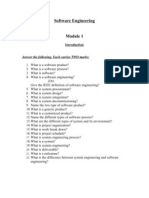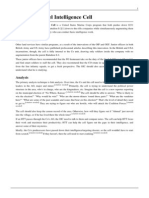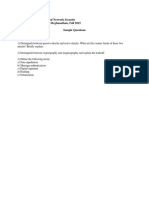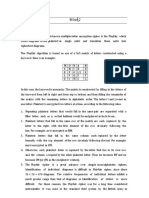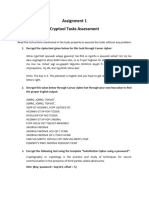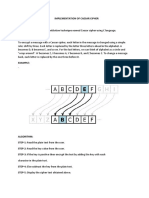Fall 2006 Chris Christensen MAT/CSC 483
Cryptanalysis of the Vigenère Cipher The keyword of a Vigenère cipher describes the rotation among the Caesar cipher alphabets that are used. That rotation leads to patterns that can be exploited by a cryptanalyst. If we know the length of the keyword, we can often determine the keyword and, hence, decrypt all messages encrypted with that keyword. Here is a ciphertext message that has been encrypted with a Vigenère cipher.
nifon aicum niswt luvet vxshk nissx wsstb husle chsnv ytsro cdsoy nisgx lnona chvch gnonw yndlh sfrnh npblr yowgf unoca cossu ouoll iuvef issoe xgosa cpbew uormh lftaf cmwak bbbdv cqvek muvil qbgnh ntiri ljgig atwnv yuvev iorim cpbsb hxviv buvet vxshk uorim mjbdb pjrut fbueg ntgof yuwmx miodm ipdek uuswx lfjek sewfy yssnm zscmm bpgeb huvez ysaag usaew mffvb wfgim qpilw bbjeu yfbef vbfrt mtwnz uorig wpbvx hjsnm zpfag uhsnm npglb jbqrh mttrh huwek mpfak ljjen hbbnh ooqew vzdak udvum yucbx yoquf vffew vzonx hjumt lfgef vmwnz uxsiz bumag xbbtb kvotx xumpx qswtx l
Assume that, somehow, we have discovered that the keyword has length five (which is conveniently the same as the size of the blocks). Then the first letter of each block is encrypted with the same row of the Vigenère square – they are encrypted with the same Caesar cipher. Similarly, the second letter of each block is encrypted with the same row – the same Caesar cipher. The third letters with the same Caesar cipher. The fourth letters with the same Caesar cipher. And, the fifth letters with the same Caesar cipher. Because Caesar ciphers are easily broken by frequency analysis, we can discover the letters of the keyword. Here is how we can proceed. Strip off the first letters of each block and do a frequency analysis on the result. They should have all been encrypted with the same Caesar cipher.
1
Alphabet number one – first letters of each block
A 11 B 11111 C 11111111 D E F 1 G 1 H 1111111 I 1111 J 1 K 1 L 11111111 M 1111111 N 11111111 O 11 P 1 Q 111 R S 11 T U 111111111 V 1111111 W 111 X 111 Y 1111111111 Z 11
It appears that ciphertext
Y
corresponds to plaintext
e
. (Not just because it is the most frequent letter but because all the high frequency letter patterns fit –
U
would correspond to
a
;
C
would correspond to
i
;
H
and
I
would correspond to
n
and
o
; and
L
,
M
, and
N
would correspond to
r
,
s
, and
t
.) Now recall that when we are encrypting using a Vigenère square plaintext
a
corresponds to the first letter of the row being used – the letter of the keyword being used. So, it appears that (because
U
corresponds to
a
) the first letter of the keyword is
u
. The keyword is
u _ _ _ _
.
2
Alphabet number two – second letters of each block
A B 11111111 C D 11 E 1 F 11111111 G 1 H 111 I 1111111 J 11111 K L M 11 N 1111 O 11111111 P 1111111111 Q 1 R S 1111111 T 111111 U 11111111111111 V 1 W X 1111 Y Z 11
It appears that ciphertext
F
corresponds to plaintext
e
. So, it appears that (because
B
corresponds to
a
) the second letter of the keyword is
b
. The keyword is
u b _ _ _
.
3
Alphabet number three – third letters of each block
A 11 B 111111111 C 111 D 111 E F 111111 G 1111111 H I 11 J 111 K L M 11 N O 11111111 P Q 111 R 111111 S 11111111111111111 T 11 U 11 V 1111111111 W 111111111 X Y Z
It appears that ciphertext
S
corresponds to plaintext
e
. So, it appears that the third letter of the keyword is
o
. The keyword is
u b o _ _
. (Perhaps, you can already guess the keyword.)
4





